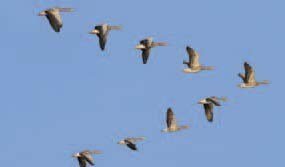Why Do Birds Fly in V Formation

By Samba Lampich
The near-perfect V formed by flying geese, ducks and other birds migrating is always a sight to behold.
Scientists have long speculated that the birds, like a squadron of planes, fly in the V formation to conserve energy but have not been able to prove this theory until recently.
Willing Winged Collaborators
Researchers from the Royal Veterinary College at the University of London in Hatfield took advantage of an existing project that reintroduces endangered Northern Bald Ibises to Europe to study why they fly
in a V. Some of the researchers hand-raised the birds which were accustomed to wearing harnesses and took them on training flights in Austria. The scientists fitted the harnesses of 14 ibises with
lightweight custom-made data loggers and used microlight planes to guide the birds along the 600-
mile migration route from Austria to Italy. Each datalogger was equipped with a GPS, accelerometer, gyrospcope, magnetometer, memory card, battery and microcontroller. Every seven minutes, these recorded the birds’ position, speed, and wing-flap during the 43 minutes of migratory flight.
Drafting off Each Other
The findings revealed that each ibis positioned itself an average of four feet behind the bird in front of
it and at about a 45° angle to catch the rising air or ‘upwash’ generated by the flapping bird in front while avoiding ‘downwash’. This results in a reduction of air resistance, reducing some of the drag that the birds would otherwise have to overcome. So every bird that is behind another feels a reduction in drag
“This can give a bit of a free ride for the bird that’s following,” said Dr Portugal Lead researcher. “So the other bird wants to put its own wingtip in the upwash from the bird in front.” But scientists also discovered that the birds also precisely timed their wing beats so they would always catch the ‘upwash’ of the bird in front. If they got a little behind or closer they would instantly adjust their wing beats.
Portugal explained: “They’re seemingly very aware of where the other birds are in the flock and they put themselves in the best possible position.” Other long-winged birds such as storks, ducks and geese, are also likely to position themselves in a similar manner during migratory flights. While the study didn’t calculate how much energy the birds saved, but previous studies estimate that birds can use 20% to 30% less energy while flying in a V.
Follow the Leader
Future studies by the researchers will focus on how the birds decide who will be the leader and set the pace. They also want to determine whether the flock blindly follows the leader or if the birds correct course and speed if the leader makes a mistake.
Classroom Discussion
- Other than conserving energy why else would bird or fighter jets fly in a V formation?
- What other formations do birds fly in?